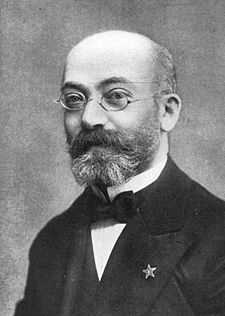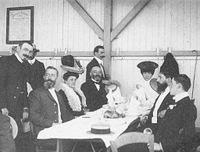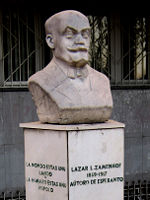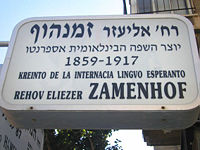L. L. Zamenhof
| L. L. Zamenhof | |
 |
|
| Born | Eliezer Samenhof December 15, 1859 Białystok, Podlachia (then Russian Empire, now Poland). |
|---|---|
| Died | April 14, 1917 (aged 57) Warsaw, Poland. |
| Known for | Constructing Esperanto |

|
|
|---|
| This article is part of the Esperanto series |
| Language |
| Grammar · Phonology · Orthography · Vocabulary · Etymology |
| History |
| Zamenhof · Proto-Esperanto · Unua Libro · Declaration of Boulogne · Fundamento · Manifesto of Rauma · Montevideo Resolution · Prague Manifesto |
| Culture and media |
| Esperantist · Esperantujo · Film · La Espero · Libraries · Literature · Music · Native speakers · Pop culture references · Publications · Symbols · Zamenhof Day |
| National Associations |
| Australia · Britain · British Youth · British Labour · Canada · Quebec · USA |
| Organizations and services |
| Amikeca Reto · Esperanto Academy · Kurso de Esperanto · Encyclopedia · Pasporta Servo · Plouézec Meetings · TEJO · UEA · SAT · World Congress · Youth Congress · Congress of the Americas · Skolta Esperanto Ligo |
| Criticism |
| Propedeutic value · Gender · Esperantido · Reformed · vs. Ido · vs. Interlingua · vs. Novial |
| Related topics |
| Auxiliary language · Constructed language · Ido · Interlingua · Novial · Occidental · Volapük · · Anationalism |
| Wikimedia |
| Portal · Task force · Vikipedio · Vikivortaro · Vikicitaro · Vikifonto · Vikilibroj · Vikikomunejo · Vikispecoj |
Ludwig Lazarus Zamenhof (pronounced /ˈzɑːmɨnhɒf/ in English; born Eliezer Samenhof, December 15, 1859 – April 14, 1917) was an ophthalmologist, philologist, and the inventor of Esperanto, a constructed language designed for international communication.
As of 1975, Esperanto was taught in 600 schools to 20,000 students per year; and there were about 100 journals and 7500 books written in Esperanto, including translations from 65 languages. In addition, it had by that time been used in more than 700 international conferences. As of 2000, per Cambridge Encyclopedia, it had somewhere between 1 and 15 million speakers, according to sources referenced.
Contents |
Cultural background
Zamenhof was born on December 15, 1859 in the town of Białystok (now in Poland, then part of the Russian Empire) to parents of Lithuanian Jewish descent. He considered his native language to be his father's Russian (or perhaps Belarusian, which was not considered distinct from Russian at the time and which appears to have had a strong influence on Esperanto phonology), though he also spoke his mother's Yiddish; as he grew older, he spoke more Polish, and that became the native language of his children.[1] His father was a German teacher, and he also spoke that fluently. Later he learned French, Latin, Greek, Hebrew and English, and had an interest in Italian, Spanish and Lithuanian.
In addition to the Yiddish-speaking Jewish majority, the population of Białystok was made up of three other ethnic groups: Poles, Germans, and Belarusians. Zamenhof was saddened and frustrated by the many quarrels between these groups. He supposed that the main reason for the hate and prejudice lay in mutual misunderstanding, caused by the lack of one common language that would play the role of a neutral communication tool between people of different ethnic and linguistic backgrounds.
Work for an international language
As a student at secondary school in Warsaw, Zamenhof made attempts to create some kind of international language with a grammar that was very rich, but also very complex. When he later studied English, he decided that the international language must have a simpler grammar. Apart from his parents' native languages Russian and Yiddish and his adopted language Polish, his lingustics attempts were also aided by his mastering of German, a good passive understanding of Latin, Hebrew and French, and a basic knowledge of Greek, English and Italian.[2]
By 1878, his project Lingwe uniwersala was almost finished. However Zamenhof was too young then to publish his work. Soon after graduation from school he began to study medicine, first in Moscow, and later in Warsaw. In 1885, Zamenhof graduated from a university and began his practice as a doctor in Veisiejai and since 1886 as an ophthalmologist in Płock and Vienna. While healing people there he continued to work on his project of the international language.
For two years he tried to raise funds to publish a booklet describing the language until he received the financial help from his future wife's father. In 1887, the book titled as "Lingvo internacia. Antaŭparolo kaj plena lernolibro" (International Language. Foreword And Complete Textbook) was published under the pseudonym "Doktoro Esperanto" (Doctor Hopeful), from which the name of the language derives. For Zamenhof this language wasn't merely a communication tool, but a way of promoting the peaceful coexistence of different peoples and cultures.
Work on Yiddish language and Jewish issues
In 1879, Zamenhof wrote the first grammar of the Yiddish language, which he published in part years later in the Yiddish magazine "Lebn un visnshaft" (Life and Science, Vilnius, 1909; see Esperanto translation as «Pri jida gramatiko kaj reformo en la jida» in «Hebreo el la geto: de cionismo al hilelismo», Eldonejo Ludovikito, vol. 5, 1976). Complete original Russian text of this manuscript with parallel Esperanto translation was only published in 1982 (translated by Adolf Holzhaus in «L. Zamennhof, provo de gramatiko de novjuda lingvo», Helsinki, p. 9-36). In this work, not only does he provide a review of the Yiddish grammar, but also proposes its transition to the Latin script and other orthographic innovations. In the same period, Zamenhof wrote some other works in Yiddish, including perhaps the first survey of the Yiddish poetics (see p. 50 in the above-cited book).
In 1882, a wave of pogroms in the Russian empire motived Zamenhof to take part in the early Zionist movement, the Hibbat Zion. [3] He left the movement in 1887, and in 1901 published a statement in Russian with the title Hillelism, in which he argued that the Zionist project could not solve the problems of the Jewish people. [4]
In 1914, he politely declined an invitation to join a new organization of Jewish Esperantists, the TEHA. In his letter to the organizers, he said: "I am profoundly convinced that every nationalism offers humanity only the greatest unhappiness... It is true that the nationalism of oppressed peoples -- as a natural self-defensive reaction -- is much more excusable than the nationalism of peoples who oppress; but, if the nationalism of the strong is ignoble, the nationalism of the weak is imprudent; both give birth to and support each other..."[5]
Among the many works Zamenhof translated into Esperanto is the Hebrew Bible or Old Testament.
Zamenhof died in Warsaw on April 14, 1917, and is buried in the Okopowa Street Jewish Cemetery in that city.

Religious philosophy
Besides his linguistic work, Zamenhof published a religious philosophy he called Homaranismo (loosely translated as humanitarianism), based on the principles and teachings of Hillel the Elder.
Children
Zamenhof and his wife Klara raised three children: a son, Adam, and two daughters, Sofia and Lidia. All three perished in the Holocaust.
Lidia Zamenhof in particular took a keen interest in Esperanto, and as an adult became a teacher of the language, traveling through Europe and to America to teach classes in it. Through her friendship with Martha Root, Lidia accepted Bahá’u’lláh and became a member of the Bahá’í faith. As one of its social principles, the Bahá’í faith teaches that an auxiliary world language should be selected by the representatives of all the world's nations.
Name discrepancy
Zamenhof's parents gave him the Hebrew name Eliezer, which appeared on his birth certificate in its Yiddish form Leyzer. In his adolescence he used both Leyzer and the Russian equivalent Lazar (the form Lazarus is often used in English texts). In some Russian documents Lazar was followed by the patronymic Markovich.
While at university, Zamenhof began using the gentile Russian name Lyudovik (often transcribed Ludovic; Polish Ludwik; in English the form Ludwig is also used) in place of Lazar. When his brother Leon became a doctor and started signing his name "Dr L. Zamenhof", Lyudovik reclaimed his birth name Lazar and from 1901 signed his name "Dr L. L. Zamenhof". The two L's do not seem to have specifically represented either name, and the order Ludovic Lazarus is a modern convention.
Zamenhof may have chosen the name Lyudovik in honor of Francis Lodwick (or Lodowyck), who in 1652 had published an early conlang proposal.[6]
His family name was written Samenhof in German orthography; Zamenhof is an Esperantized spelling.
Honors and namesakes

In 1910, Zamenhof was nominated for the Nobel Peace Prize, by four British Members of Parliament (including James O'Grady, Philip Snowden) and Professor Stanley Lane Poole.[7] The Prize was instead awarded to the International Peace Bureau.
The minor planet (1462) Zamenhof is named in his honor. It was discovered on February 6, 1938 by Yrjö Väisälä. Also, hundreds of city streets, parks, and bridges worldwide have been named after Zamenhof[8]. In Lithuania, the best-known Zamenhof Street is in Kaunas, where he lived and owned a house for some time. There are others in France, Hungary, Poland, Czech Republic, Spain (mostly in Catalonia), Italy, Israel, and Brazil. There are Zamenhof Hills in Hungary and Brazil, and a Zamenhof Island in the Danube River.[9]

In some Israeli cities, street signs identify Esperanto's creator and give his birth and death dates, but refer to him solely by his Jewish name Eliezer (the origin of Lazarus). Zamenhof is honored as a deity by the Japanese religion Oomoto. Also, a genus of lichen has been named Zamenhofia rosei in his honour.[10]
His birthday, December 15, is celebrated annually as Zamenhof Day by users of Esperanto.
Notes
- ↑ In a letter to a Th. Thorsteinsson dated 1901 March 08 he wrote, Mia gepatra lingvo estas la rusa; sed nun mi parolas pli pole... "My mother tongue is Russian, but now I speak more Polish..." See also his biographers A. Zakrzewski and E. Wiesenfeld.
- ↑ Holzhaus, Adolf: Doktoro kaj lingvo Esperanto. Helsinki : Fondumo Esperanto. 1969
- ↑ N. Z. Maimon "La cionista periodo en la vivo de Zamenhof" (in Esperanto) See external link below.
- ↑ N. Z. Maimon "La cionista periodo en la vivo de Zamenhof" (in Esperanto) See external link below.
- ↑ N. Z. Maimon "La cionista periodo en la vivo de Zamenhof" (in Esperanto) See external link below.
- ↑ Umberto Eco & James Fentress (September 9, 1995). The Search for the Perfect Language. Blackwell Publishing. p. 324. ISBN 0-631-17465-6.
- ↑ Nobel Prize nomnination database
- ↑ See the list of Zamenhof/Esperanto Objects on the wikipedia in Esperanto
- ↑ Hommages au Dr Zamenhof, à l’espéranto et à ses pionniers.
- ↑ Zamenhofia rosei: Francis' lichen. Range, habitat, biology.
References
- Elwood, Ann (1975). "Toward a Universal Language".. Garden City NY: Doubleday and Company. ISBN 0-385-04060-1.
- Le Petit Robert: 'Zamenhof'. Paris; Montréal: Dictionnaires Le Robert, 1990. ISBN 2-85036-074-0.
- Schmadel, Lutz D (1993). Dictionary of Minor Planet Names (2 ed.). Berlin; New York: Springer-Verlag. ISBN 3-540-66292-8.
- Wincewicz, A; M. Sulkowska; S. Sulkowski (2007). "To heal the mind's eye of hate--Dr. Ludwik Zamenhof.". Isr Med Assoc J 9 (5): 352–4. PMID: 17591370. http://www.ima.org.il/imaj/ar07may-2.pdf.
In the mystery novel "The Yiddish Policemen's Union," by Michael Chabon, the hotel where Detective Landsman lives is called the Zamenhof.
See also
- The Life of Zamenhof (book)
External links
- XXXI High School of L. Zamenhof, Lodz, Poland (in English)
- Works by L. L. Zamenhof at Project Gutenberg (In Esperanto)
- ZAMENHOF, LAZARUS LUDWIG by Joseph Jacobs, Isidore Harris. Jewish Encyclopedia, 1906 ed.
- N. Z. Maimon "La cionista periodo en la vivo de Zamenhof" (in Esperanto)
| Persondata | |
|---|---|
| NAME | Zamenhof, Ludvic Lazarus |
| ALTERNATIVE NAMES | Ludwik Lejzer, Ludwik Łazarz |
| SHORT DESCRIPTION | Inventor of Esperanto |
| DATE OF BIRTH | December 15, 1859 |
| PLACE OF BIRTH | Białystok, Russian Empire (now Poland) |
| DATE OF DEATH | April 14, 1917 |
| PLACE OF DEATH | Warsaw, Kingdom of Poland |